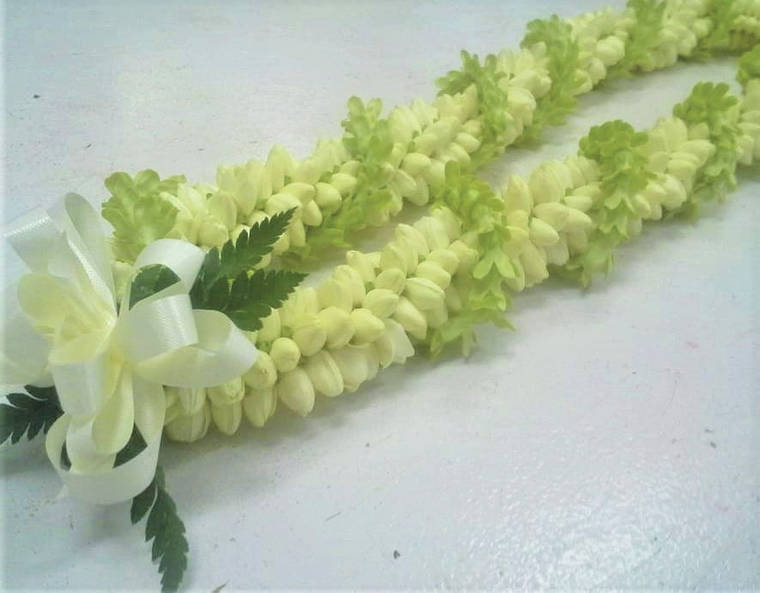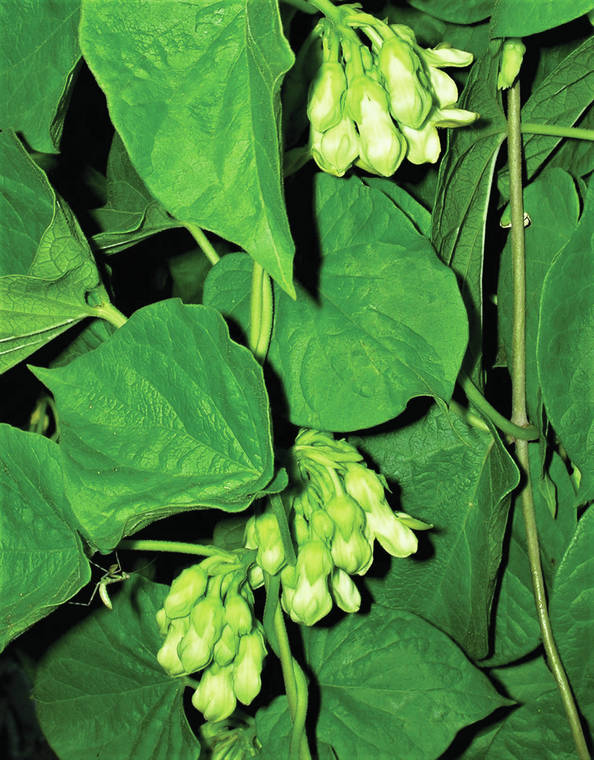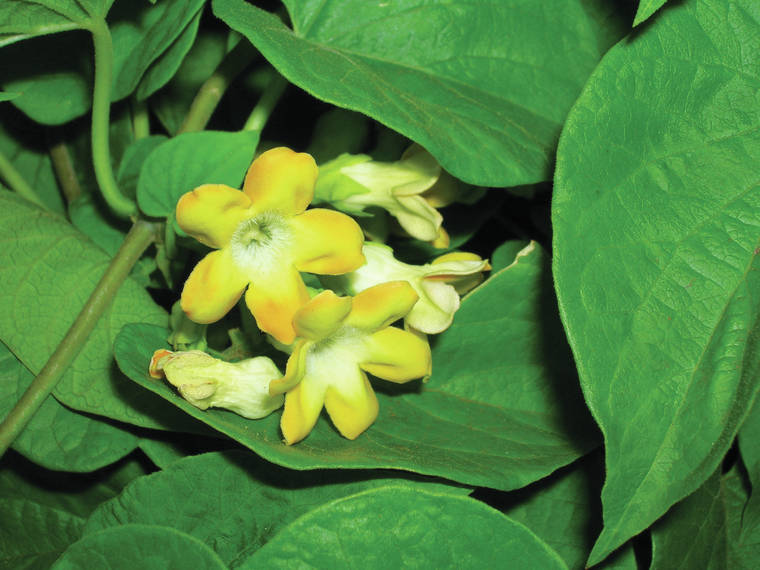Opportunities to add fragrance to our gardens abound here in Hawaii. To mention a few, we have plumeria trees, gardenias, gingers, pikake, puakenikeni, and tuberose. All beautiful plants with big bold aromas. You might want to consider adding something more delicate to your collection that also packs a sensory wallop.
Pakalana is a slender vining plant with little yellow-green flowers that have a heavy lemony fragrance similar to ylang-ylang. A member of the milkweed (Asclepiadaceae) family, pakalana, known botanically as Telosma ororatissima, has the characteristic milky sap of the family and shares other features with cousins like stephanotis and crown flower.
Native to China and Southeast Asia, pakalana is sometimes known as Chinese violet as it was introduced and popularized here by Chinese immigrants. The plant is now cultivated throughout the tropics and it may occur in the wild as an introduced species in many locales.
Here in Hawaii, the flowers are usually grown to add fragrance to a garden or for incorporation into a lei. In her native countries, pakalana is also considered a vegetable and many recipes using the flowers (sometimes known as cowslip creeper) can be found on the internet. They are eaten raw and often added to rice or used in soups or curries. When fresh they are crisp, succulent and tender with a mild, subtly sweet and earthy flavor.
Pakalana grows as a thin vine that is not especially beautiful. It definitely requires support to grow to its full length, which can be 10 to 15 feet. A trellis, fence or tree are good supportive candidates but the vine does not provide a thick screen. Also, pakalana vines have a rather short life span of around five years. These factors are forgiven, however, when pakalana blooms and her fragrance fills the garden.
The vine has bright green heart shaped leaves that can be up to 5 inches long. Though the individual flowers are only about a half-inch across, they appear in dangling clusters that often contain more than 15 blooms all packed with perfume.
A well-established pakalana plant will start to bloom in the spring once the days get longer and will slow down or stop flowering during the shorter days of winter. Planting now to get your pakalana well established could result in a bounty of blooms next spring.
Following flowering, vines occasionally produce long green seed pods that eventually turn brown. At this point the pods easily open to reveal lots of small seeds, each with a hairy tuft allowing them to catch and float away on a passing breeze. Since seed pods appear rarely, the plant has not become invasive. It can, however, be easily cultivated from garden seeds or those you can purchase online.
For best results, start pakalana seeds in a pot filled with a potting soil that can stay moist but drains well. Push the seeds about ½ inch into the damp soil and cover lightly. Within a month the seeds should germinate and the vine will start growing. Successful propagation can also be done from pakalana cuttings that might take as long as 60 days to root.
Plant it out in the garden or in a large container in an area that has full sun exposure but is protected from wind and salt spray. Providing a good support for the vine and making sure the soil is fertile and drains well will keep your pakalana happy and healthy.
Pakalana plants will usually start to flower as day length increases in the spring. Working a fertilizer high in phosphorus into the root zone as the spring during the spring bloom season begins can boost bloom production.
A healthy pakalana plant will not usually succumb to insect or disease attacks. To keep your plant healthy don’t overwater, over fertilize or over prune. You want to avoid root rot, too much vegetative growth and the inadvertent removal of potentially flowering stems. Practice a little tough love for best results.
Though you may have to call around to find pakalana plants, your search will be handsomely rewarded with a bounty of fragrance. Once you find a plant, place it on a trellis outside your bedroom window and enjoy aromatic nights all summer long.
Diana Duff is a plant adviser, educator and consultant living part time in Kailua-Kona.
Gardening Events
Every Saturday: “Work Day at Amy Greenwell Garden” from 9 a.m. to 12:30 p.m. Meet at the Garden Visitor Center across from the Manago Hotel in Captain Cook. Come with a mask and be prepared to practice social distancing. Volunteers can help with garden maintenance and are invited to bring a brown bag lunch. Water and snacks provided. Call Peter at 323-3318 for more information.
Farmer Direct Markets (check websites for the latest hours and online markets)
Wednesday: “Ho‘oulu Farmers Market” at Sheraton Kona Resort &Spa at Keauhou Bay
Saturday: “Keauhou Farmers Market” 8 a.m. to noon at Keauhou Shopping Center
Information on their online market at keauhoufarmersmarket.com/onlinemarket
“Kamuela Farmer’s Market” 7:30 a.m. to noon at Pukalani Stables
“Waimea Homestead Farmers Market” from 7:30 a.m. to noon at the Waimea middle and elementary school playground
Sunday: “Pure Kona Green Market” 9 a.m. to 2 p.m. at Amy Greenwell Garden in Captain Cook
“Hamakua Harvest” 9 a.m. to 2 p.m. at Highway 19 and Mamane Street in Honoka‘a
Plant Advice Lines
Anytime: konamg@ctahr.hawaii.edu; Tuesdays and Thursdays from 9 a.m. to noon at UH-CES in Kainaliu at (808) 322-4893.











